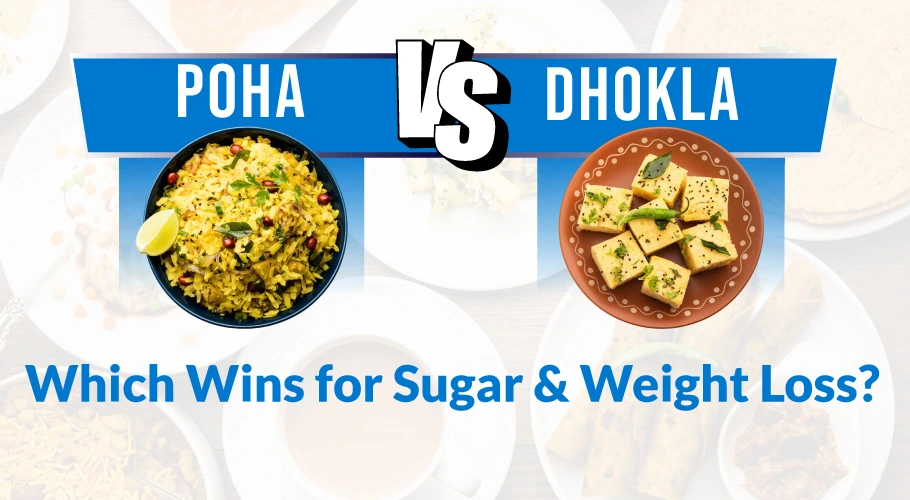Poha vs Dhokla for Breakfast: What’s Better for Diabetics and Weight Loss?

When it comes to choosing the right breakfast, the question often comes down to Poha vs Dhokla. Both are light, popular Indian breakfast dishes, but if you're aiming for better health, weight loss, or sugar control, one of them might suit your needs more than the other. Let’s break down the facts.
Poha or Dhokla for Breakfast: What's in Your Plate?
Poha is made from flattened rice, typically cooked with onions, mustard seeds, turmeric, curry leaves, and sometimes peanuts or potatoes. It’s quick, comforting, and rich in iron.
Dhokla, on the other hand, is made from fermented gram flour (besan) or mixed dals, steamed into a soft, spongy texture. It’s low in fat, packed with protein, and often topped with mustard seeds, curry leaves, and green chillies.
However, one important note to get these benefits, homemade Dhokla without added sugar is ideal. Many commercial or restaurant Dhoklas may contain sweeteners or excess oil, which can reduce its effectiveness as a truly healthy breakfast. Stick to steamed, home-prepared versions with minimal oil and sugar-free tempering for best results.
So, Poha vs Dhokla for breakfast, which one truly wins? Let’s compare.
Nutritional Face-Off: Poha vs Dhokla Calories and Macros
|
Nutrient (per 100g) |
Poha |
Dhokla |
|
Calories |
110–130 kcal |
140–150 kcal |
|
Carbohydrates |
19–23g |
18–25g |
|
Protein |
2.4–4g |
7–12g |
|
Fiber |
0.9–3.4g |
2–4g |
|
Fat |
1–3g |
1–2g |
|
Glycemic Index (GI) |
~60 |
~31–40 |
If you're tracking Poha vs Dhokla calories, Dhokla may be slightly higher per gram, but it also offers significantly more protein and fiber, making it more filling and supportive of weight loss and blood sugar control.
Poha vs Dhokla for Diabetes
From a diabetic perspective, Dhokla is the better option. With its low glycemic index and higher fiber, it provides steady energy without causing sharp sugar spikes. In contrast, Poha, with a moderately high GI, digests quickly, potentially raising blood sugar levels faster.
This makes Poha vs Dhokla for diabetes a clear choice in favor of Dhokla especially if you’re using a CGM or managing insulin resistance.
Poha vs Dhokla for Weight Loss
Looking at Poha vs Dhokla for weight loss, Dhokla again offers an advantage. Its fermentation boosts gut health, while the high protein and fiber content keeps you full longer helping prevent cravings and overeating.
That said, Poha isn’t a bad option. It can be made healthier with additions like sprouts, vegetables, and lemon, which increase fiber and lower the glycemic load.
Light and Healthy Breakfast Options: Why Dhokla Wins?
Both Poha and Dhokla qualify as light and healthy breakfast options, especially when compared to fried snacks. But if you’re choosing based on satiety, gut health, blood sugar stability, and overall nutrient density, Dhokla comes out ahead.
Still love Poha? Enjoy it occasionally, but tweak your platekeep portions moderately, skip the sev, and pair it with veggies or sprouts to reduce the glycemic impact.
Final Word
So, which is healthier, Poha or Dhokla? For most people, especially those managing weight or diabetes, Dhokla offers more long-term benefits. But both can be part of a balanced breakfast if made thoughtfully. It all depends on your health goals and how you prepare your plate.
Looking for more healthy breakfast options for diabetics? Visit our blog.
FAQs
- Which is healthier for breakfast, Poha or Dhokla?
Dhokla is generally healthier due to its high protein, fiber, and low glycemic index. - Is Poha or Dhokla better for weight loss?
Dhokla helps more with weight loss as it promotes satiety and gut health. - Which is more suitable for diabetics – Poha or Dhokla?
Dhokla is safer for diabetics due to its lower glycemic index and better blood sugar control. - Does Poha have more calories than Dhokla?
No. Dhokla may have slightly more calories, but offers better protein and fiber. - Which is easier to digest, Poha or Dhokla?
Poha is easier to digest, making it ideal when you want something light. - Can I eat Poha or Dhokla daily for a healthy breakfast?
Yes, in moderation and with balance. For diabetics or weight watchers, Dhokla is preferable more often. - Which has a lower glycemic index – Poha or Dhokla?
Dhokla has a significantly lower glycemic index (~31–40) compared to Poha (~60).

